October 28, 2025 | 18:53 GMT +7
October 28, 2025 | 18:53 GMT +7
Hotline: 0913.378.918
October 28, 2025 | 18:53 GMT +7
Hotline: 0913.378.918
In recent years, despite a general context of numerous difficulties, such as institutional and policy bottlenecks and limited investment resources, the team of scientific staff in the agricultural sector has upheld a strong spirit of professional passion and deep responsibility toward the sector and the farming community. Through proactive efforts and determination to overcome challenges, the sector has achieved many important results, specifically:
- Significant contributions have been made to the restructuring of the agricultural sector. A wide range of scientific and technological advances have been researched and applied in production, helping to improve the productivity, quality, and added value of many key agricultural products such as rice, coffee, rubber, and aquatic products. As a result, the sector’s economic structure and agricultural production structure have continued to shift in a more appropriate direction, integrating multiple values, operating more efficiently in line with market demands, and increasing the proportion of sub-sectors and products with competitive advantages and high value, while ensuring quality and food safety.

In the context of limited resources, agricultural scientists in recent years have demonstrated an exceptional spirit of professional passion and a deep sense of responsibility toward the sector and farming communities. Photo: Hoang Vu.
The application of science and technology now spans all areas, including crop cultivation, plant protection, animal husbandry, veterinary medicine, aquaculture, forestry, irrigation, and post-harvest technology. This contributes to the promotion of production, processing, and business along value chain linkages. This has fostered the development of modern, large-scale, closed production zones that meet the stringent demands of the market. Technology transfer activities have been actively implemented across all agricultural fields, helping reduce investment costs, increase profitability, and deliver high economic efficiency in production.
- Development of plant and animal breeds and new technical advances: Over the past five years, more than 120 new plant and animal breeds have been developed, many of which are climate-resilient, cost-saving, and meet export standards. In addition, over 500 technical advances have been recognized and applied in production, contributing to increased productivity, quality, and value of many key agricultural products such as rice, coffee, rubber, and aquatic products.
The expertise of domestic scientists has also improved significantly, reflected in successful research on applying genetic technology to breed crop varieties resistant to pests, diseases, and adverse environmental conditions, as well as in applying plant genome editing techniques. Advances have been made in perfecting processes for producing frozen livestock semen, inducing estrus and artificial insemination for buffalo and cattle, and producing high-quality frozen semen in straw form.
The aquaculture sector has also experienced a strong transformation thanks to science and technology applications. Numerous high-value aquatic species such as barramundi, golden pompano, drum fish, Chinese longsnout catfish, Hemibagrus, weather loach, sea cucumber, spotted Babylon snail, and various cold-water fish species have been successfully bred artificially, with farming technologies mastered domestically.
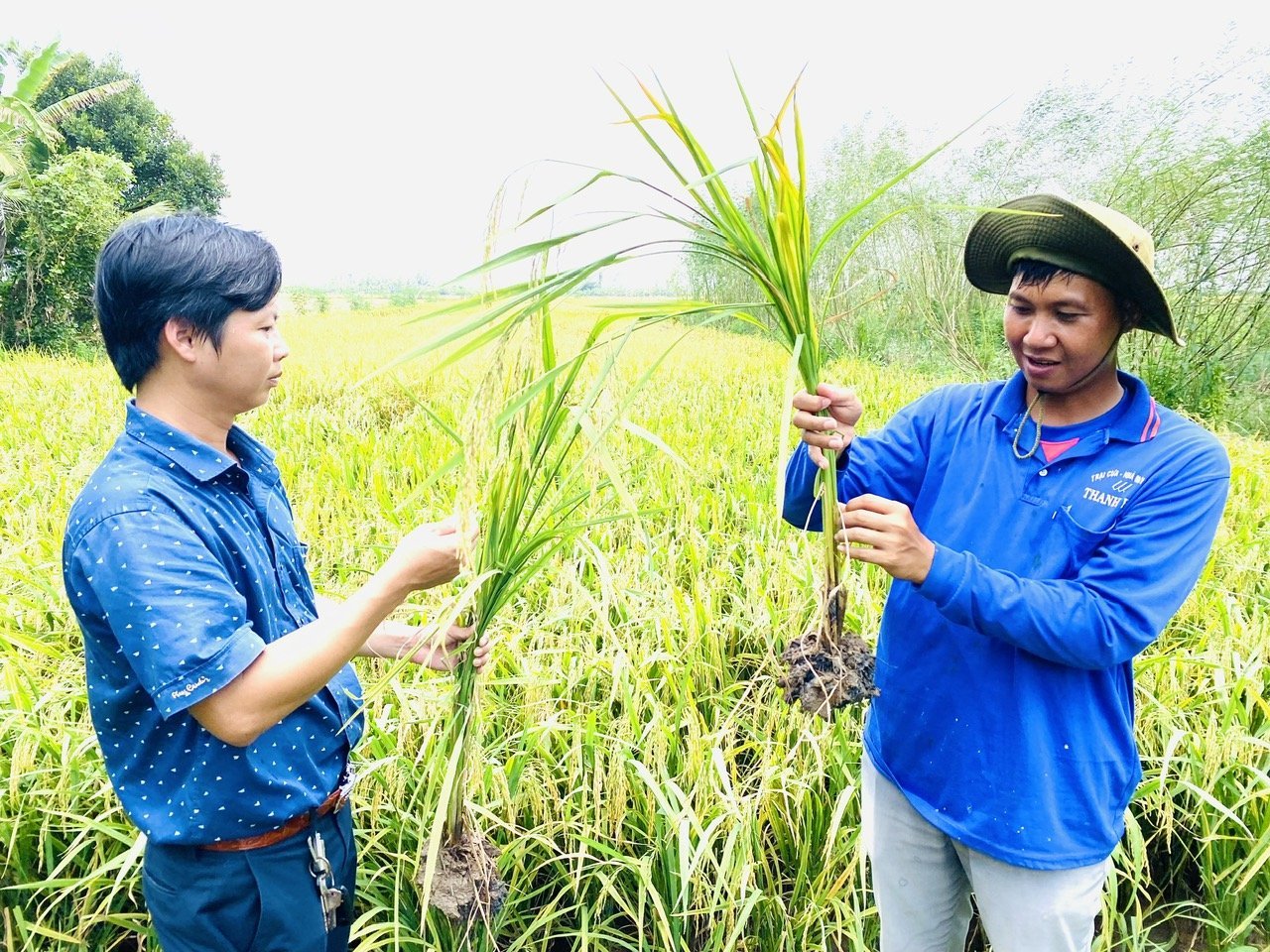
Over the past five years, more than 120 new plant and animal breeds have been developed. Photo: Hoang Vu.
Forestry has also been a bright spot in the application of science, technology, and innovation. In recent years, Vietnam’s forestry sector has achieved 78 recognized plant varieties, 35 technical advances, and 11 patented inventions and utility solutions. Notably, the AA9 Acacia auriculiformis variety planted in the Southeast region has achieved yields of up to 34 m³/ha/year - more than three times that of conventional varieties, equivalent to hybrid acacia yields. In 2024, the total concentrated planted forest area is estimated at about 282,000 hectares, up 0.2%, with an additional 130 million scattered trees. The harvested timber output from planted forests is estimated at 22.88 million m³, an increase of 9.8%.
- Scientific and technological research outcomes have not only helped maintain stable food production but have also promoted green, circular, and low-emission agriculture. Alongside the shift toward green thinking - green action - green agriculture across all areas of crop cultivation, animal husbandry, aquaculture, and forestry, the sector has consistently aligned with the policy of developing ecology-oriented, modern rural areas, and cultured farmers, thereby contributing significantly to the Government’s goal of building a green economy.
- Strong adoption of high technology and digital transformation has been achieved through the advancement and application of genetic engineering, high-tech solutions, smart production models adapted to climate change, product traceability, and pest management using biotechnology.
With the robust application of information technology and biotechnology, the process of developing new rice varieties has become far more efficient. It now takes only 30-50 hybrid combinations to develop a new rice variety (compared to about 100 in the past), shortening the breeding time to around 3-5 years. This significantly reduces both time and labor while meeting nearly all key requirements: high yield, good grain quality, short growth duration, strong pest resistance, and broad adaptability. As a result, the export price of rice has risen from 350-400 USD/ton to 550 USD/ton.
The production of vegetables and fruit trees has seen steady growth in area, yield, and output in recent years, with an increasingly diverse range of varieties. While in the previous term only dragon fruit achieved export revenue exceeding 1 billion USD, in the current term durian has reached a similar milestone, and many other potential export crops are under research and development.
- Enhancing international cooperation has enabled the reception and transfer of advanced technologies and the expansion of export markets. Numerous research and technology transfer projects have been implemented in partnership with international counterparts, helping broaden market access and improve the sector’s science and technology capacity. Bilateral, multilateral, and regional cooperation has been strengthened through conferences and dialogues (both in person and online) with global partners to effectively implement international treaties and agreements in agriculture, while also mobilizing, attracting, and efficiently managing foreign aid. The sector has successfully engaged international organizations and bilateral/multilateral donors, including China, Japan, South Korea, FAO, UNDP, WWF, WB, and ADB to provide funding and technical support.
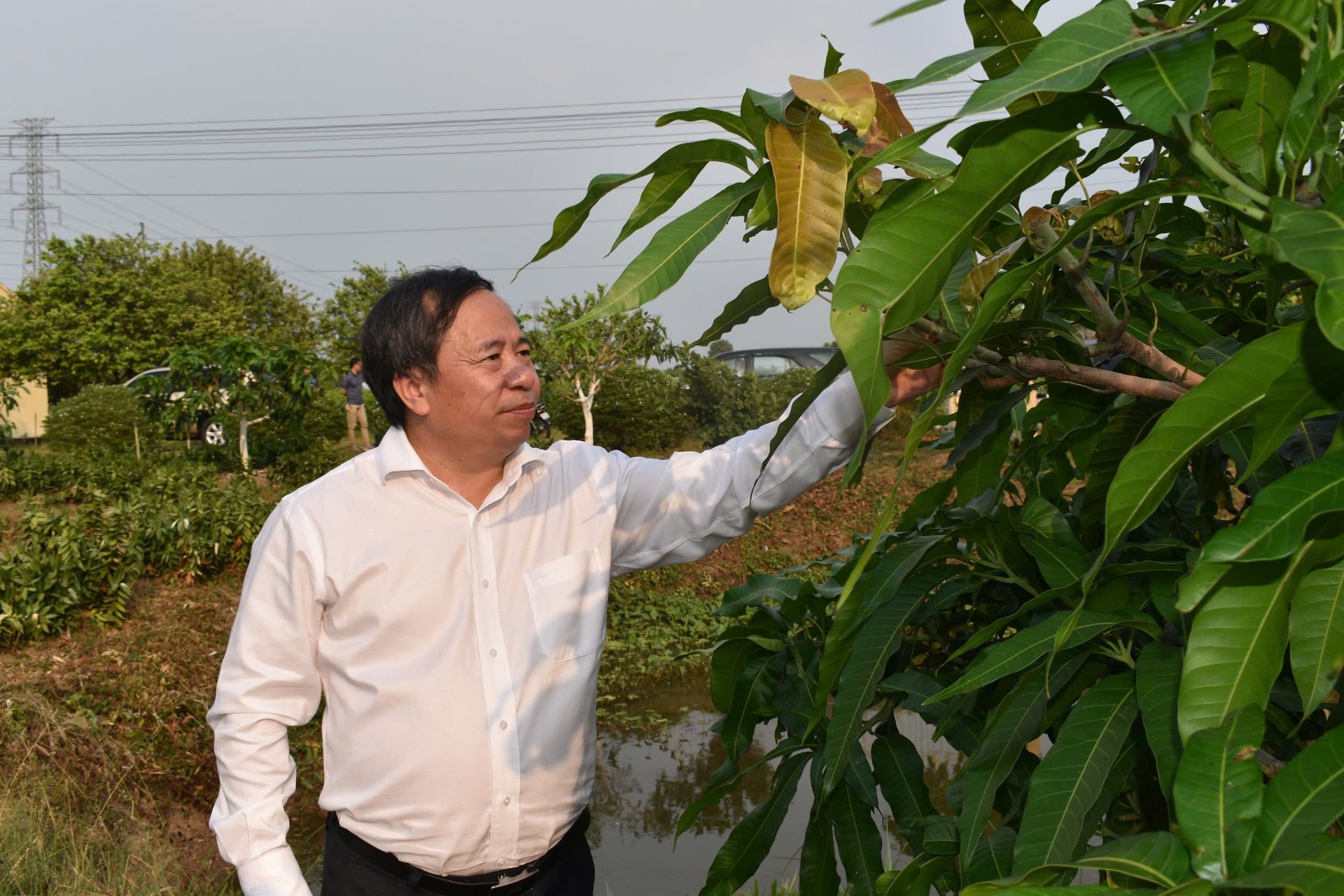
Professor Dr. Nguyen Hong Son inspects fruit tree development in provinces of the Mekong Delta. Photo: Minh Dam.
In the past term, the Party Committee of the Ministry of Agriculture and Rural Development (now the Ministry of Agriculture and Environment) has demonstrated consistent leadership and direction in science and technology work, reflected in the following:
Providing strategic guidance and issuing resolutions and action programs to reform and enhance the effectiveness of science and technology activities, ensuring research is closely linked to the practical needs of production and market demands.
During 2020–2024, the agriculture sector continued to implement Resolution No. 19-NQ/TW dated June 16, 2022, of the 13th Central Committee of the Communist Party of Vietnam on agriculture, farmers, and rural areas; the Strategy for Sustainable Agriculture and Rural Development for 2021–2030; and the Agricultural Restructuring Plan for 2021-2025.
Leading scientific organization and personnel management: Focusing on training, fostering, and promoting the scientific workforce; encouraging creativity, bold thinking, and decisive action.
Mobilizing resources: Actively integrating multiple funding sources, promoting socialization, and strengthening public–private partnerships to implement research and technology transfer.
Linking science and technology with the sector’s political missions: Prioritizing research topics and projects that directly serve agricultural restructuring, the development of key products, and climate change adaptation.
Thanks to the close leadership and sound direction of the Ministry’s Party Committee, science and technology activities in the agricultural sector during the past term have achieved outstanding results. They have made significant contributions to the sustainable development of agriculture and rural areas and improved people's livelihoods.
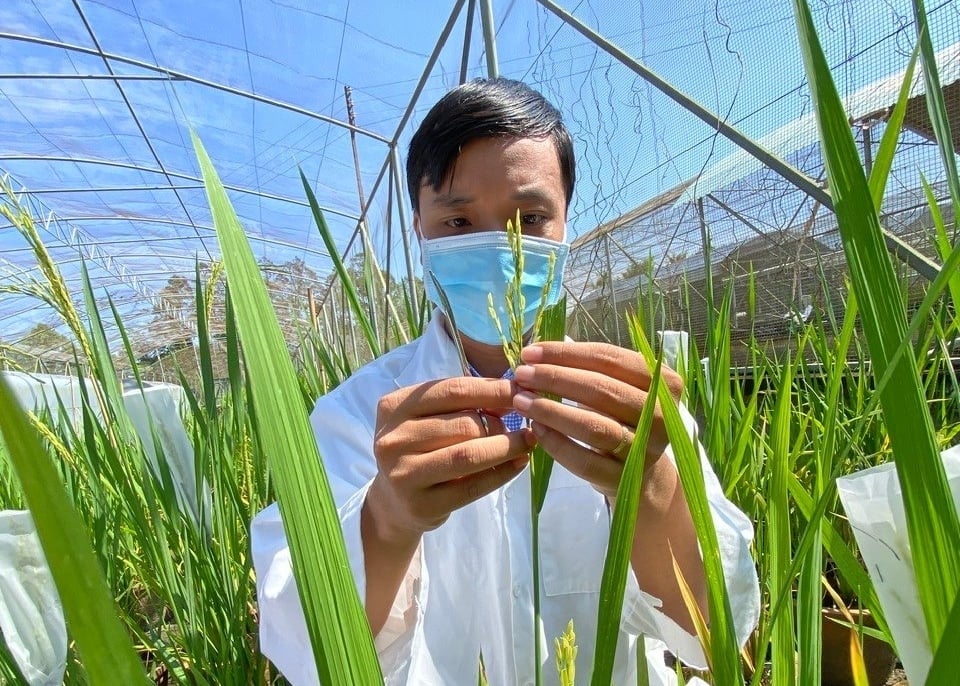
Resolution 57 of the Politburo opens up a golden opportunity for a breakthrough in agricultural science and technology. Photo: Hoang Vu.
Resolution 57 of the Politburo creates a golden opportunity for science and technology to become the primary driving force for restructuring the agricultural sector, increasing added value, and ensuring sustainable development. My expectations are as follows:
- Establish national-level research and innovation clusters for rice, aquaculture, fruit trees, industrial crops, and ecological agriculture.
- Achieve breakthroughs in breeding and biotechnology, mastering genetic technologies to develop multiple generations of new crop and livestock breeds, along with valuable genetic materials possessing exceptional traits in quality, pest and disease resistance, and adaptability to adverse conditions.
- Focus on researching technical solutions to improve product quality in connection with deep processing; research and apply models for organizing and managing production according to sustainable value chains.
- Conduct comprehensive research and apply digital transformation in agricultural production, management, and trade, forming a large-scale agricultural data ecosystem. Promote green, circular, and low-emission agriculture, fully utilize by-products, and effectively adapt to climate change.
- Invest in upgrading research facilities, equipment, and human resource training to achieve advanced regional standards, meeting the requirements of the new development phase - one that shifts from quantity-focused research and development to quality-focused R&D, ensuring food safety and linking with green, sustainable growth and climate change adaptation.
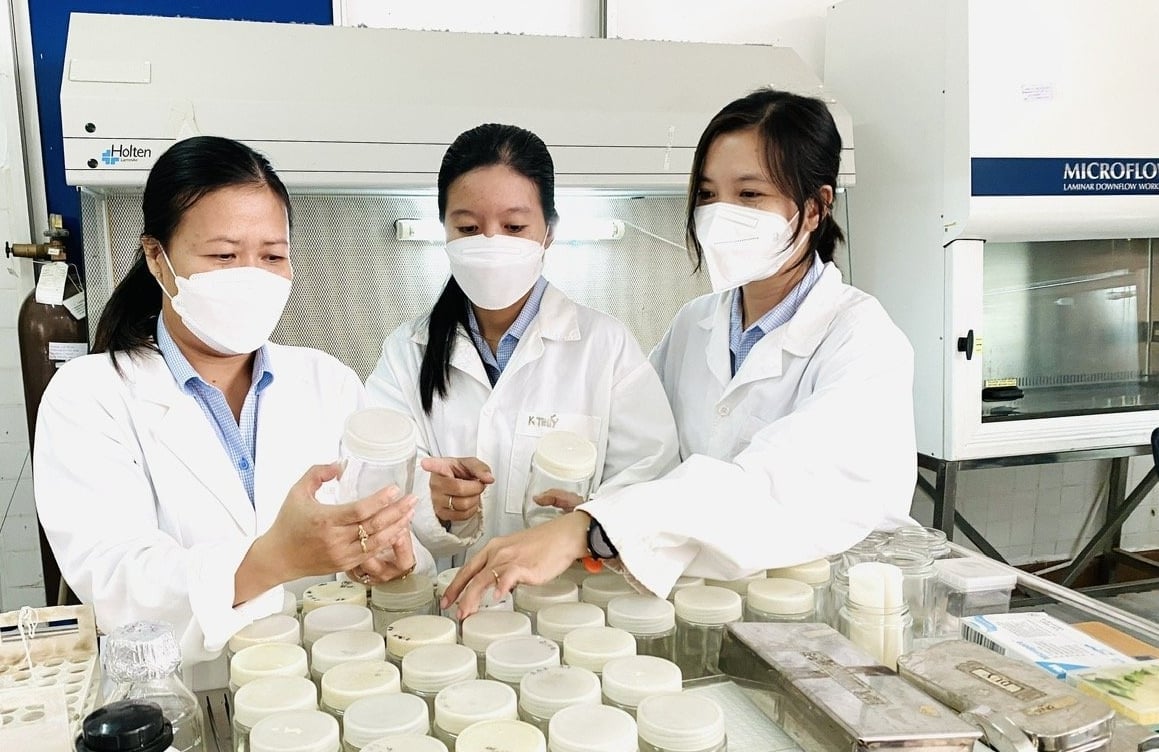
According to Professor Dr. Nguyen Hong Son, it is essential to establish a dedicated research fund to support science and technology as soon as possible. Photo: Hoang Vu.
- Promptly study and review adjustments to mechanisms and policies particularly those related to scientific autonomy, “invest first - support later” investment mechanisms, as well as regulations, especially in the field of finance. A research fund should be quickly established, based on state budget support and revenues from production and business activities, especially by allocating a portion of export revenue to supplement S&T. This funding would be partly used to maintain the stable operation of research organizations and partly returned to the organizations and individuals whose results directly benefit the specific exported products, thereby encouraging greater investment in scientific research.
To strengthen research capacity in line with the new development requirements, in the coming period, the Vietnam Academy of Agricultural Sciences will focus on several key tasks:
- Continue reviewing and streamlining the organizational structure to avoid overlaps and enhance investment efficiency and coordination among basic research institutes, specialized institutes, and regional institutes.
- Strengthen basic research to build a solid scientific foundation for developing breakthrough technologies that create high-quality products meeting food safety standards, in connection with the application of high technology and digital transformation.
- Accelerate the application of genetic engineering and biotechnology to improve the traits of major crop varieties such as rice, maize, coffee, and cashew, focusing on pest and disease resistance, tolerance to adverse conditions, suitability for mechanized farming, and deep processing. For other crops, particularly fruit trees, vegetables, and flowers, modern genetic techniques such as mutation breeding and genetic engineering will be combined with traditional crossbreeding to develop superior traits.
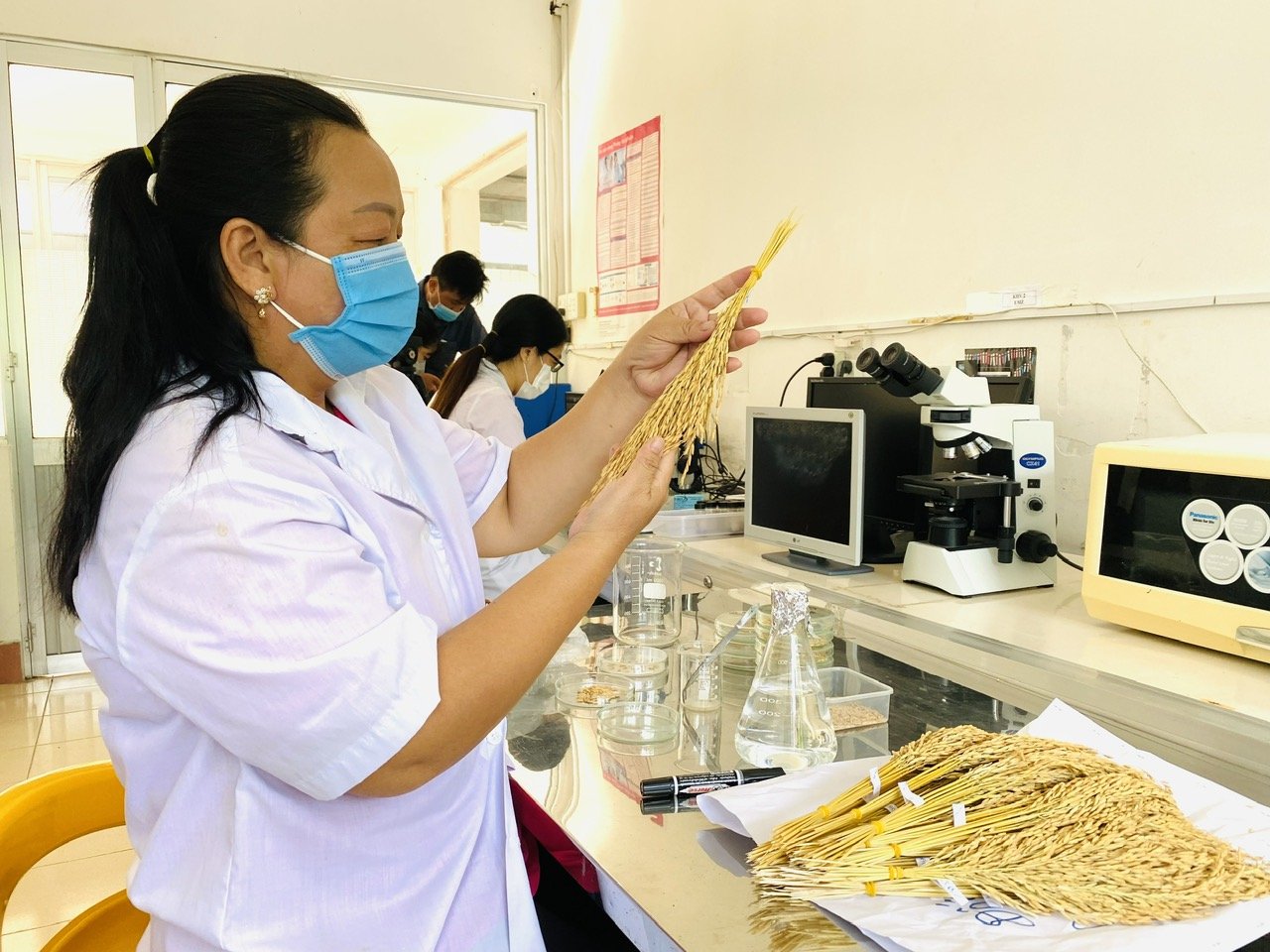
The Vietnam Academy of Agricultural Sciences will continue reviewing and streamlining its organizational structure to avoid overlaps, improve investment efficiency, and strengthen coordination among its member institutes. Photo: Hoang Vu.
- Enhancing research and development capacity: The Academy will leverage state budget support and international cooperation resources to invest in upgrading infrastructure and human resources, ensuring the establishment of modern, centralized laboratories on par with regional and international standards. This will be combined with the synchronized improvement of laboratories, greenhouses, net houses, and experimental fields, alongside personnel training, to improve research quality. The aim is to create breakthrough products in terms of quality, food safety, and industrialization, while also helping to reduce production costs.
- Reforming the science and technology management system is another priority, to foster proactivity, creativity, and technological ownership among scientists. The Academy plans to train a highly specialized workforce and develop leading experts in each field.
- Promoting international cooperation: The Academy will expand partnerships with institutes, universities, and international organizations to gain access to advanced technologies, share experiences, and mobilize resources.
In the upcoming term, I hope that the Party Committee of the Ministry of Agriculture and Environment will give due attention to and provide strategic direction for the long term, establishing a vision for the sector’s science and technology development through 2050, in alignment with sustainable development and international integration. I expect leadership to drive a transformation in research thinking, encourage breakthrough studies, and ensure their rapid application in practice. There should be clear guidance to mobilize multi-channel resources, linking state budget funds, corporate capital, and international cooperation for science and technology development. Furthermore, effective monitoring and evaluation must be in place to ensure that S&T products have a tangible impact on farmers’ livelihoods and significantly enhance the competitiveness of Vietnamese agricultural products.
Translated by Kieu Chi

(VAN) According to Deputy Minister Nguyen Hoang Hiep, just 20 days after the appeal was launched, Viet Nam received assistance from 30 countries and international organizations, with a total value of USD 9.7 million.

(VAN) SEAMAP and ROMONA sign a 2025 - 2028 Memorandum of Understanding, marking a new chapter in Viet Nam’s marine geodesy and positioning technology development.

(VAN) UNICEF, in cooperation with the Ministry of Agriculture and Environment, has provided 800 water storage tanks, 800 essential hygiene kits, and 80,000 water purification tablets to people affected by the recent floods.

(VAN) More than 32,000 plant genetic samples currently preserved in Vietnam’s National Genebank are laying the foundation for the establishment of a National Botanical Garden and the development of climate-resilient crop varieties.

(VAN) Viet Nam is emerging as a strong potential contributor to the ASEAN Economic Community, thanks to its outstanding competitiveness in manufacturing and production.

(VAN) On October 25, the VDDMA received emergency aid from Singapore for people affected by recent disasters.

(VAN) The Viet Nam Academy of Science and Technology and the Finnish Meteorological Institute have signed a five-year Memorandum of Understanding.